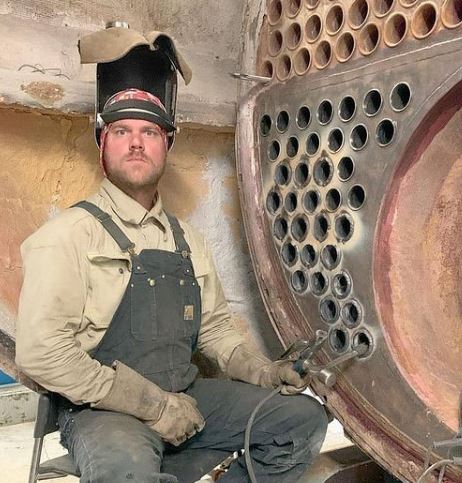Inconel is a high-performance nickel-chromium alloy known for its excellent corrosion resistance and high strength at elevated temperatures. It is commonly used in various industries, including aerospace, chemical processing, and power generation.
Tig welding, or tungsten inert gas welding, is a popular process that uses a non-consumable tungsten electrode to produce a high-quality, corrosion-resistant weld. It is often the preferred method for welding Inconel because it produces clean, precise welds with minimal distortion.

Tig Welding Inconel
Welding Inconel, a type of nickel-based superalloy, can be challenging due to its high resistance to corrosion and extreme temperatures. However, with the right skills and proper equipment, it is possible to achieve strong, high-quality welds on Inconel using tig welding. This guide will discuss the challenges and solutions for tig welding Inconel.
Challenges Of Tig Welding Inconel
One of the main challenges of tig welding Inconel is its high melting temperature, ranging from 2500 to 2600°F (1370 to 1430°C). This requires high-heat inputs and can make it difficult to achieve good fusion and penetration in the weld.
Inconel also has a high coefficient of thermal expansion, which can lead to weld distortion and cracking if not properly compensated for.
Another challenge is that Inconel can be prone to forming oxides on the surface, which can interfere with the weld and lead to defects.
Overall, tig welding Inconel requires a high level of skill and attention to detail to produce clean, uniform welds that meet the necessary strength and corrosion resistance requirements.
Solutions For Tig Welding Inconel
One solution for overcoming the high melting temperature of Inconel is to use specialized tig welding rods designed specifically for Inconel. These rods often have a higher nickel content and may also contain other elements that help improve Inconel’s weldability.
Preheating and post-weld heat treatment can also reduce the risk of cracking and defects in Inconel welds. Preheating helps reduce the thermal stresses that can occur during welding, while post-weld heat treatment can help improve the weld’s microstructure and overall strength.
Proper joint preparation is also crucial for the successful tig welding of Inconel. This includes cleaning the joint surfaces to remove contaminants or oxides and properly aligning and clamping the parts to be welded.
In addition to using the right equipment and techniques, using the right shielding gas is also important for tig welding Inconel. Argon is often the preferred choice due to its ability to provide a stable, inert environment for the weld.
What Causes Inconel To Crack?
Several factors can cause Inconel to crack during the welding process. One of the main causes is overheating, which can occur when the welding temperature is too high, or the heat is not properly distributed across the joint. Inconel is also prone to cracking due to the formation of high residual stresses in the welded joint, which can be caused by factors such as improper preheat, rapid cooling, and high restraint. Other factors that can contribute to Inconel cracking include incorrect filler metal, improper joint design, and contamination of the weld area.
Why Is Tig Welding So Hard?
TIG welding can be challenging for several reasons. One of the main challenges is the need for precise control of the welding process, as TIG welding requires using a non-consumable tungsten electrode to produce the weld. This requires the welder to maintain a steady hand and to carefully control the movement of the electrode and the filler metal. TIG welding also requires a high level of concentration and attention to detail, as any mistakes or deviations from the proper technique can result in poor-quality welds. Additionally, TIG welding requires specialized equipment and consumables, which can be expensive and require regular maintenance.
What Is The Cutting Speed For Inconel?
The cutting speed for Inconel, which is the speed at which the cutting tool moves through the material, is dependent on several factors, such as the type of cutting tool being used, the hardness and thickness of the material, and the desired finish quality. In general, the cutting speed for Inconel should be lower than for other materials due to the high hardness and strength of the alloy. For example, when using a lathe to cut Inconel, a cutting speed of 50-70 feet per minute (FPM) may be appropriate for a rough cut, while a slower speed of 20-30 FPM may be more suitable for a finished cut. It is important to consult the manufacturer’s recommendations and to test the cutting speed and feed rate to determine the optimal values for a particular application.
What Is The Most Difficult Weld To Perform?
There is no single answer to this question, as the difficulty of a weld depends on various factors, such as the type of material being welded, the thickness and shape of the material, the welding process being used, and the skill and experience of the welder. Some welding processes, such as TIG welding, are generally more challenging due to the need for precise control and the use of specialized equipment. Welding certain materials, such as Inconel, can also be challenging due to the high melting point and tendency to crack. Ultimately, the difficulty of a weld will depend on the specific conditions and requirements of the project.
Do You Preheat Inconel?
It is generally recommended to preheat Inconel before welding to help reduce the risk of cracking and improve the overall quality of the weld. Preheating involves heating the area to be welded to a specific temperature before starting the welding process. Preheating Inconel helps reduce the amount of thermal shock the material experiences during welding, which can reduce the risk of cracking. The recommended preheat temperature for Inconel will depend on the thickness of the material and the specific welding process being used. It is important to consult the manufacturer’s recommendations and to follow proper preheat procedures to ensure the best results.
Conclusion
In conclusion, tig welding Inconel presents several challenges due to its high melting temperature and tendency to form oxides on the surface. However, by using specialized tig welding rods, preheating and post-weld heat treatment, proper joint preparation, and the right shielding gas, it is possible to achieve strong, corrosion-resistant welds in Inconel. It is important to carefully consider these factors and use the appropriate techniques and equipment to achieve the best possible results when welding Inconel.

It’s been years since I got into welding as a side hustle. It’s been so long since Doing All kinds of welds for business and pleasure as this is my hobby. Being in this field I have learned from hands-on-experience also came to know what gears work and what doesn’t. The Tig Welder is my own platform where I use to share my experience.






Leave a Reply